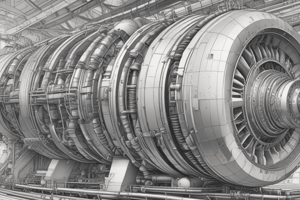Podcast
Questions and Answers
What is a state in thermodynamics?
What is a state in thermodynamics?
- A system's path from one equilibrium to another
- A type of flow process
- A condition of a system at a specific point in time (correct)
- A process that occurs at constant temperature
What type of process occurs when the temperature of a system changes?
What type of process occurs when the temperature of a system changes?
- Isothermal process
- Isobaric process
- Isochoric process
- None of the above (correct)
What is a path in thermodynamics?
What is a path in thermodynamics?
- A state of equilibrium
- A constant-pressure process
- A series of states through which a system passes during a process (correct)
- A type of flow process
What occurs when a fluid enters a control volume with a different state than when it exits?
What occurs when a fluid enters a control volume with a different state than when it exits?
What is a cycle in thermodynamics?
What is a cycle in thermodynamics?
What is a property in thermodynamics?
What is a property in thermodynamics?
What is a quasi-equilibrium?
What is a quasi-equilibrium?
What is a process in thermodynamics?
What is a process in thermodynamics?
What type of functions are heat and work classified as?
What type of functions are heat and work classified as?
What is a characteristic of a property X?
What is a characteristic of a property X?
What is the symbol for the change in the value of a property X?
What is the symbol for the change in the value of a property X?
What is the expression for the change in the value of a property X?
What is the expression for the change in the value of a property X?
What is an example of an intensive property?
What is an example of an intensive property?
What happens when two or more systems with intensive properties are brought together?
What happens when two or more systems with intensive properties are brought together?
What type of quantity is dependent on the path of the process?
What type of quantity is dependent on the path of the process?
What is a characteristic of a path function?
What is a characteristic of a path function?
What is the term used to describe the pressure of a system measured relative to the atmosphere?
What is the term used to describe the pressure of a system measured relative to the atmosphere?
What is the relationship between absolute pressure, gauge pressure, and atmospheric pressure?
What is the relationship between absolute pressure, gauge pressure, and atmospheric pressure?
What is the force balance equation for the fluid element in the pressure variation with elevation?
What is the force balance equation for the fluid element in the pressure variation with elevation?
What is the relationship between the pressure and the elevation of a fluid?
What is the relationship between the pressure and the elevation of a fluid?
What is the formula for the pressure variation with elevation?
What is the formula for the pressure variation with elevation?
What is the term used to describe the measurement of pressure using a column of fluid?
What is the term used to describe the measurement of pressure using a column of fluid?
What is the main distinction between a closed system and an open system?
What is the main distinction between a closed system and an open system?
What is the zeroth law of thermodynamics related to?
What is the zeroth law of thermodynamics related to?
What is the statement of the zeroth law of thermodynamics?
What is the statement of the zeroth law of thermodynamics?
What is the pressure at which the ice point exists?
What is the pressure at which the ice point exists?
What is the primary function of a system boundary?
What is the primary function of a system boundary?
At what temperature does water boil in Celsius?
At what temperature does water boil in Celsius?
What is a control volume?
What is a control volume?
What is a property in thermodynamics?
What is a property in thermodynamics?
What is the lowest temperature possible?
What is the lowest temperature possible?
What is the temperature of Absolute Zero in Fahrenheit?
What is the temperature of Absolute Zero in Fahrenheit?
What defines the thermodynamic state of a system?
What defines the thermodynamic state of a system?
What is a thermodynamic process?
What is a thermodynamic process?
What is the characteristic of Absolute Zero?
What is the characteristic of Absolute Zero?
What is the temperature of water freezing in Kelvin?
What is the temperature of water freezing in Kelvin?
What is a path in thermodynamics?
What is a path in thermodynamics?
What is the difference between a cycle and a flow process?
What is the difference between a cycle and a flow process?
Flashcards are hidden until you start studying
Study Notes
Introductory Concepts and Definitions
- A system can be classified as closed, open, or isolated.
- System boundaries may be drawn to reflect the type of analysis one wishes to perform.
- A control volume is defined by a surface (real or imaginary) enclosing a volume of interest.
Properties and States
- A property is a quantifiable macroscopic characteristic of a system (e.g., mass, volume, density, pressure, temperature, etc.).
- The thermodynamic state of a system is defined by the values of all of its thermodynamic properties.
- A process occurs whenever a system changes from one state to another state.
Types of Processes
- Constant-temperature process: isothermal.
- Constant-pressure process: isobaric.
- Constant-entropy process: isentropic.
- Constant-volume process: isochoric.
Path and Point Functions
- Path functions are quantities that are not properties of the system and depend on the path of the process undergone by the system (e.g., heat and work).
- The change in the value of a property is independent of the path, hence: ∫dX = X2 - X1.
Extensive and Intensive Properties
- An intensive property is one that does not depend on the mass of the system (e.g., temperature, pressure, density, and velocity).
- Intensive properties are not summed when two or more systems are brought together.
Thermodynamic Pressure
- The pressure of a system is usually measured relative to the atmosphere (gauge pressure).
- Absolute pressure = Gauge pressure + Atmospheric pressure.
Pressure Variation with Elevation
- Pressure varies with altitude or depth: ∂P/∂Z = -ρg.
Manometry
- P = Patm + PHg.
Temperature Scale
- Temperature is a measure of molecular activity.
- The zeroth law of thermodynamics states that if two systems are equal in temperature to a third, they are equal in temperature to each other.
- The ice point and steam point are chosen to establish a temperature scale, with a number of subdivisions created between them.
- The Kelvin scale is designed to go to zero at absolute zero, where all atomic and molecular motion stops.
Important Reference Points
- Water boils at 100°C or 373 K.
- Water freezes at 0°C or 273 K.
- Absolute zero occurs at 0 K or -273.15°C or -460°F.
Studying That Suits You
Use AI to generate personalized quizzes and flashcards to suit your learning preferences.





